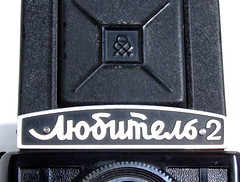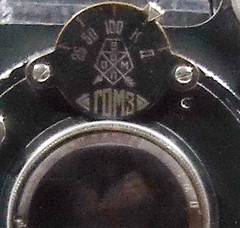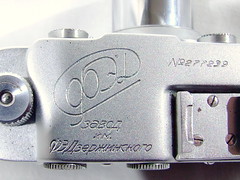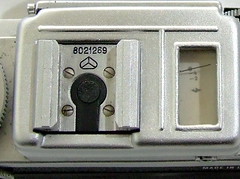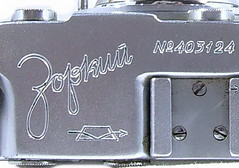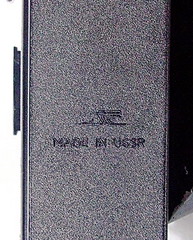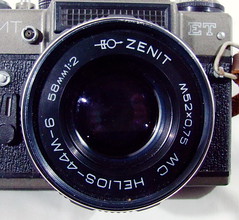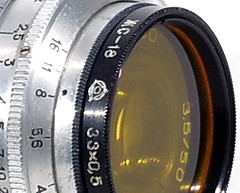
Soviet best quality logo
Most items of photographic equipment from the Soviet Union are marked with the logo of the factory where they were made.
Soviet best quality logo
It is suppossed to indicate that the item it is on is the equal of any other similar item world wide.
|
| ||||
| GOMZ factory logo on Lubitel-2; VOOMP logo and very early GOMZ logo on Fotokor-1. Images by Süleyman Demir (Image rights) | |||||
Factories
Arsenal
Zavod Arsenal (Завод Арсенал = Arsenal Factory), Kiev, Ukraine. Arsenal is one of the oldest and most famous industrial factories in Soviet Union and later Ukraine. The factory mainly specialized in optical components for the Soviet military and space programs. The factory also produced the professional grade photographic cameras. They were Kiev 135 film and 120 film series, Salyut series, and some others.
Belomo
Belomo (Belorussian Optical and Mechanical Association) formed in 1971 by the merger of MMZ and the Vilejka Factory, and apparently Peleng. BelOMO continued to produce cameras and lenses, cine cameras, accessories, projectors, etc. The plants may continue to use their original logos on the products produced in each plant of the association.
FED
F.E. Dzerzhinsky Factory, Kharkov, Ukraine. FED is the initials of F. E. Dzerzhinsky, the founder of the NKVD, in honor of him the factory was named. The NKVD was the People's Commissariat for Internal Affairs (= Народный комиссариат внутренних дел = Narodnyy Komissariat Vnutrennikh Del, (НКВД = NKVD), a secret police organization of the Soviet Union later known as the KGB. The factory was originally an orphanage workforce was based on youths living and working together in a commune. After the groundbreaking introduction of the Leica II in 1932, Soviet leaders stopped the import of photographic equipment and set the FED factory to its task of creating a Leica of their own. Only 18 months later, in 1934, the FED factory began churning out its first clone of the Leica II rangefinder camera. Since then, they have produced millions of cameras, some good and some not so good. The variations in the engravings on the FED camera tops make it worth a special mention, reflecting the changes within the Soviet Union.
GOMZ
State Optical-Mechanical Factory (= Государственный оптико-механический завод, Ленинград, ГОМЗ, Gosularstvennyi Optiko-Mekhanicheskii Zavod, Leningrad). It was the manufacturer of the early series of the famous Lubitel cameras. One of the biggest Soviet camera industry giant was GOMZ . In 1962 GOMZ became a part the Leningrad Optical and Mechanical Association of Enterprises (LOOMP), (= Ленинградское объединение оптико-механических предприятий, ЛООМП), In 1965 the name changed again as Leningrad Optical-Mechanical Union. (LOMO), (= Ленинградское Oптико-Mеханическое Oбъединение, ЛОМО́). Fotokor-1 folding bed, Reporter folding, Efte folding, Komsomolets TLR, Smena 35mm series, Leningrad 35mm rangefinder series and some other cameras were manufactured in GOMZ also.
KMZ
KMZ logo, early

KMZ logo, early
Krasnogorsky Mekhanichesky Zavod KMZ (Красногорский механический завод = Mechanical Factory of Krasnogorsk), near Moscow. KMZ is known largely for its cameras like Iskra, Kristall, Mir, Moskva , Start, Zenith (early series), Zorki series and some others. Some of these were produced several millions. It also has a large military optics and mechanical engineering division.
Kazan
Kazan produced Industar 22, Industar 27,Industar 50, Industar 51, Industar 37, Jupiter 11, Jupiter 37 and Fodis 1K.
LOMO

LOMO logo
LZOS
Lytkarino Optical Glass Factory (= Лыткаринский завод Оптического Стекла LZOS), in Lytkarino, 100 km north of Moscow. It was a KMZ satellite plant, included in KMZ's production union and the most famous for manufacturing various lenses for KMZ cameras.
MMZ

MMZ logo
Minsk Mechanical Factory named by S.I. Vavilov (Minskiy Mechanichesckiy Zavod imeni S.I. Vavilova). Founded in 1957, MMZ was located in Minsk, Belarus, approximately 450 miles SW of Moscow. Initial production was optical glass and the Smena-2 camera. In 1971, MMZ became BelOMO.
Rostov
Rostov produced viewfinders.
Valdai
Optical-Mechanical Factory Valdai is located about 400km north-west of Moscow. Very little is known of this plant, but it has been a prolific producer of lenses for KMZ, and Zenit Belomo. The SLR lenses were Helios name.
Vilejka
Vilejka Factory, or officially OM RUP "ZENIT". In Soviet times it was known as Vileiskiy Zavod Zenit. Founded in early 1970 in Vilejka, near Minsk, as a Zenit camera manufacturing factory for MMZ and KMZ. The Vilejka Zenits were apparently intended primarily for home consumption, and earned a poor reputation for quality. Vilejka, has produced the following Zenit models: E, TTL, ET, 11, 15, under slightly different designations. Vilejka is apparently still producing Zenits, i.e. Zenit 130.
Vologda
Vologda produced Jupiter 21 and Helios 44.

Vologda logo
Vologda logo,late
VOOMP
In 1929 the Council of Labour and Defence of the USSR decided to join all optical and mechanical factories of the era under the same name, "Union Trust opto-mechanical enterprises" (VTOMP), (= Всесоюзный Трест Оптико-Механических предприятий ВТОМП). In 1930 VTOMP name changed as the Union of Optico-Mechanical Companies (VOOMP), (=Всесоюзное объединение оптико-механической промышленности, ВООМП). Under this name a small number of cameras and lenses were produced in the pre-war years, like folder Fotokor-1, VOOMP II Pioneer (one of the first Leica II copies made in the Soviet Union). In the transition times, VOOMP and very early GOMZ logos are seen together on the Fotokor-1 cameras. In 1932 the company was renamed again as "State Optical Mechanical Plant (GOMZ).
Zagorsk
Zagorsk produced Jupiter 3, Orion 15, Mir 1, Mir 1b and Tair 3A.
|
|
| ||||||
| FED factory logo on FED-1; Arsenal factory logo on Kiev-4M; KMZ factory logo on Zorki-1 Images by Süleyman Demir (Image rights) | ||||||||
|
|
| ||||||
| Belomo factory logo on Zenith ET; Valdai factory logo on Helios 44-M-6 lens of Zenith ET; LZOS factory logo on Yellow filter on Kristall Images by Süleyman Demir (Image rights) | ||||||||
Links
- in Communist Cameras by Nathan Dayton
- Logos of Soviet factories at Alfred's Camera Page
- The Dzerzhinsky Commune by Oscar Fricke
- Soviet and Russian Cameras by Aidas Pikiotas
- KMZ in Wikipedia
- LOMO in Wikipedia
- In Russian: Logos of Soviet factories at the KMZ archive site
- In Russian: VOOMP in Novacon
- In Russian: LOMO in ru-wikipedia
